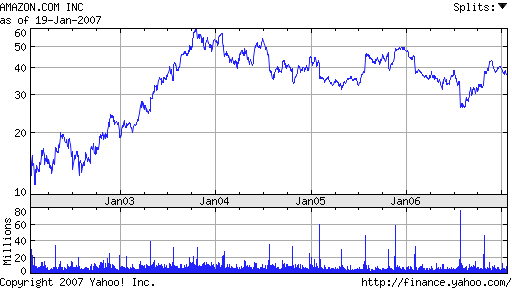Written by Alex Iskold and edited by Richard MacManus
Lately Amazon has been
introducing a raft of ‘web 2.0’ features to its e-commerce website. In this post we
explore how Amazon has implemented tagging, Ajax, blogs and wikis – and ask whether it’s
made much difference to the user experience, and to the bottom line. In previous posts,
we’ve discussed Amazon’s bold and visionary Web Services Strategy –
which is creating many success
stories. But this post is not about Amazon’s new business, it is about the
continuous innovation of their core e-commerce business.

Amazon continues to refine its web site and roll out gems that no one else has. In our
post on recommendation
engines, we discussed how it combines sophisticated personal, social and item-based
recommendation technologies to drive the user to transaction. Here is a stacked view of
some of the features we now see on Amazon.com:
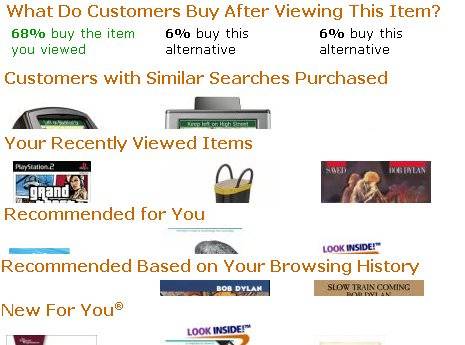
But these are just some of Amazon’s recent innovations, many others are popping up. In
this post we’re going to explore some more new features that we’ve found.
Amazon the tagging company? You betcha!
We are still in the midst of the social bookmarking and tagging revolution – at least
based on the numbers that came up in our analysis of trends using
Technorati and Seth
Godin’s list. But when people talk about tagging we think del.icio.us and Flickr, not
Amazon. Well, Amazon rolled out a tagging strategy last year and it is now working very
well. Each Amazon product can now be tagged by users and a set of tags is then shown on
the product pages. Here are the tags for the Dream Girls soundtrack:
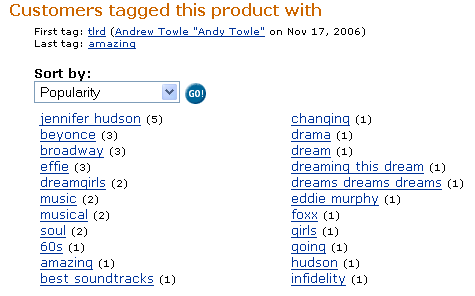
Its worth noting that there are quite a lot of tags, even though the product is
recent. This implies that customers are enthusiastic about tagging products.
Using Tags to power recommendations
What is Amazon going to do with all these tags? Well, to start with it already offers
a search for product by tag, which is a nice feature not available on most other large
ecommerce sites. But I suspect there is much more that will be done soon with Amazon
tags. It is only the matter of time before we see Find similar items by
tag. Here is why…. today on Amazon, if you are looking at a book, you get
recommendations for similar books by content. This is an
item-based recommendation – different from ‘Customer who bought X also
bought Y’, which is a social recommendation.
Amazon’s infrastructure analyses and categorizes huge volumes of text on a daily
basis. The output of these algorithms is a list of key phrases that uniquely identify any
item (e.g. a book). In my recent post
about recommendation engines, I suggested that these key phrases can be substituted by
people’s tags. It looks like Amazon will soon be in position to do just that. What this
means is that Amazon is going to be able to do item-based recommendations for all its
products, without having to analyze music, movies and houseware in the same way. This
will be another big win for Amazon and a big competitive edge, since no other retailers
have this.
Ajaxification of Amazon
But tags are only one of the “web 2.0” inspirations for Amazon. The Ajaxification of
Amazon is also taking place. Amazon is one of the oldest retail sites online, known for
its strong brand and user interface. Making drastic changes to the site is difficult, and
Amazon has always been very careful in that area. However, recently we have seen more and
more features that utilize Ajax. For example, ‘Today’s recommendations’ uses Ajax and
tags in a very effective way:
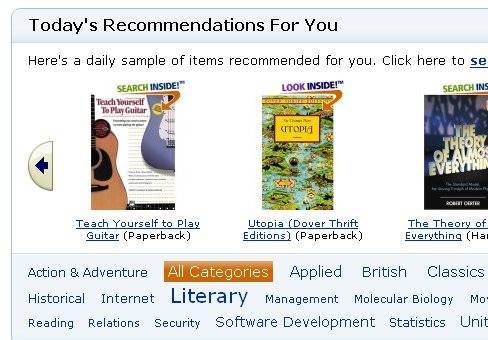
Other parts of the site are also getting more Ajaxy, moving away from the
click-to-reload paradigm. My only wish here is that Amazon implements Netflix-like
previews of items, which would save a lot of time for user.
Plogs
So Amazon has gotten tags and Ajax. But that’s not all, it also uses blogs and wikis.
Amazon’s spin on blogs is called plog. Lets look beyond the name, which
does not sound terribly exciting, to the actual function. Plogs offer a way for you to
receive personalized news from various source – like authors, manufacturers and
journalists. In a way it is similar to email, except that it displays on your personal
Amazon page.
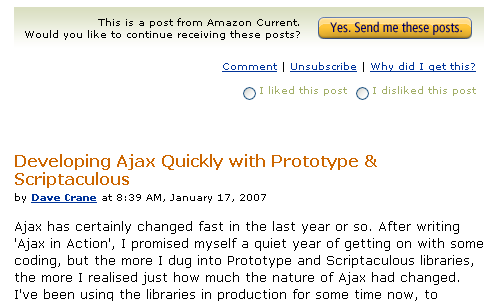
Each entry in your plog is written by a real person, but it is delivered to your plog
automatically – based on your Amazon purchase and browsing history, as well as the
ratings of other plog posts. I found most things in my plog to be highly relevant and
interesting. Amazon offers an RSS feed that I can subscribe to via my RSS reader. So this
becomes a personalized news feed from Amazon – quite interesting and unique.
Amazon Wikis
The Wikis are also very recent on Amazon and not as developed as the plogs yet. I have
to admit that this is the least favorite new feature for me, because of the way it is
implemented. To start with, it needs to be clearly distinguished from the user reviews.
The whole point of a wiki is to allow users to create a rich set of interlinked pages.
The current implementation does not deliver this. Instead the wiki is embedded right into
the page and kind of blends with the rest of the content.
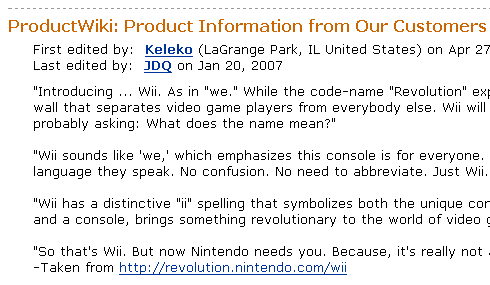
If this is to work, it needs to be redone as a regular wiki – and it needs to deliver
value beyond what is already on Amazon’s webpages, or what can be done via Wikipedia.
Why is Wall St not impressed?
So Amazon has certainly caught the web 2.0 winds and is putting those kinds of
features to good use. The company continues to innovate both as a rising web services
star and one of the best online shopping destinations. Its creativity, drive to innovate
and ability to execute is impressive. But apparently not for Wall Street. Looking at the
stock chart below, we see that its been stagnating for a the larger part of five years.
So we turn to you for comments on Amazon’s technology and future. Is Wall Street missing
something big here, or is the fancy web 2.0 technology Amazon is introducing not going to
impact their margins that much?
